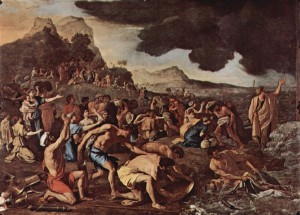Fashion and theology are concepts that the average layman would probably consider to be mutually exclusive. Fashions, after all, are ephemeral—mere passing fancies. Yet, curiously, many of our most esteemed divinity schools are now dominated by aficionados of the cutting edge theological fashion known in the trade as scriptural minimalism.
Among the leading exemplars of this school are the members of the Jesus Seminar, who, over the past couple of decades or so, have dismissed the vast bulk of the gospel record as falsehoods and fabrication.
Basically, scriptural minimalists reject virtually everything that could be described as supernatural. This, naturally, includes the miracles recorded in the Old and New Testaments. They also dismiss as myth virtually everything in the Bible for which there is no independent documentary support.
They generally concede, for example, that an earthquake could have temporarily dried up the River Jordan and brought the walls of Jericho tumbling down as recorded in the Book of Joshua. But the minimalists dismiss the story of the storming of Jericho by the children of Israel as unfounded legend on grounds that there is no independent witness.
They reject the account of Moses and the children of Israel crossing the Red Sea dry shod, first, because it is clearly miraculous and, second, because there is no independent contemporary record of it.
Such arguments might make a plausible case as far as atheists are concerned, but not so for people who believe in God or even professed agnostics. After all, if there is a God—an intelligence behind creation—why on earth (in the universe, for that matter) should he be bound by the laws he, himself, created? God, by his very nature, ought to be able to perform what we think of as miracles quite naturally.
But, in fact, there is a natural ‘earthly’ explanation for the crossing of the Red Sea. This body of water, which is relatively shallow, parts quite naturally when the wind blows as described in the Book of Exodus.And as to the lack of documentary records, the Israelites had no time or opportunity to erect celebratory monuments, while Egypt’s rulers made a habit of sweeping their failures under the carpet and recording only their triumphs.
In other words, the crossing of the Red Sea is a miracle of timing that could be written off as pure coincidence without attacking the integrity of the scripture. But that, of course, would defeat the whole purpose of the minimalists’ exercise.
Even so, the demolition—or deconstruction—of the Bible has proved rather more difficult than the minimalists anticipated. One of their earliest claims, for instance, was that the story of the patriarchs was pure myth and that Ur of the Chaldees, the city of Abraham’s birth, never existed.
In 1922 the British archaeologist Leonard Woolley (later ‘Sir Leonard’), in charge of a joint venture between the British Museum and the University of Pennsylvania, identified the city of Ur.
Among his discoveries were its royal cemeteries with a large treasure trove, including the Copper Bull and a pair of Ram in a Thicket figurines, one of which is in the British Museum, and the other in the University of Pennsylvania Museum of Archaeology and Anthropology.
Agatha Christie’s novel, Murder in Mesopotamia, was inspired by the discovery of the royal tombs. Christie later married Woolley’s young assistant at Ur, Max Mallowan.
 Archaeologists’ trowels have also confirmed the biblical record of the storming of Jericho and the grandeur of Jerusalem at the time of David. Minimalists had dismissed it as collection of mud huts. Not so, it turns out.
Archaeologists’ trowels have also confirmed the biblical record of the storming of Jericho and the grandeur of Jerusalem at the time of David. Minimalists had dismissed it as collection of mud huts. Not so, it turns out.
What’s more, a dozen years ago, a sharp-eyed archaeological surveyor made a discovery that gave the lie to minimalist claims that the great King David was simply a godlike mythical figure akin to the Greek god Apollo.
While working at Tel Dan, the site of an ancient Canaanite city, she discovered an inscribed stone that mentions ‘The House [dynasty] of David’. It had been commissioned by a non-Israelite king barely a century after David’s death.
Archaeologists have similarly confirmed New Testament accounts the minimalists have called into question. Cyrenius was indeed governor of Syria at the time of Christ’s birth. Pontius Pilate was indeed a real historical character. So, too, was Caiaphas, the high priest at the time of the Crucifixion. Archaeologists have excavated his tomb and his ‘ossuary’, the burial box that once contained his bones.
And then there is the story about the pool by the sheep market in Jerusalem, where St. John tells Jesus healed a man who had been unable to walk for 38 years.
The incident was just a figment of St. John’s imagination, declared the minimalists. Well, archaeologists unearthed the pool, complete with its five porches, a decade or so ago.
Never mind, said the minimalists, the place identified as Pool of Siloam (where Jesus sent a blind man to wash his eyes and receive his sight) was simply a shrine built in the Byzantine era, long after the time of Christ.
But lo and behold! Workmen laying a new sewer near the site unearthed the actual pool where the blind man was healed—an elegant affair, at least 225 feet wide.
With such a record, one might be forgiven for thinking the time was long past to declare it ‘game, set, and match’ in favour of the Christians, and for the minimalists gracefully to throw in the towel.
But rather than quit, they doggedly trot out new theories, urged on by a generally sympathetic media. Just because they make a lot of noise, However, there’s really no need to pay heed to them. After all, judged by their record, only a minimal response to the minimalists is needed. GPHX✠



